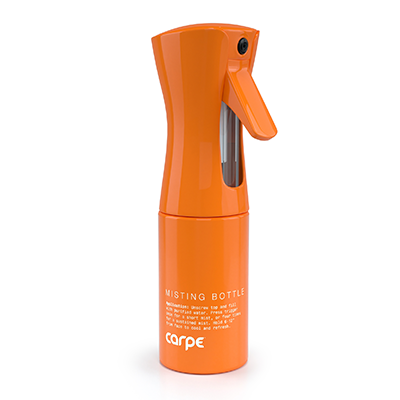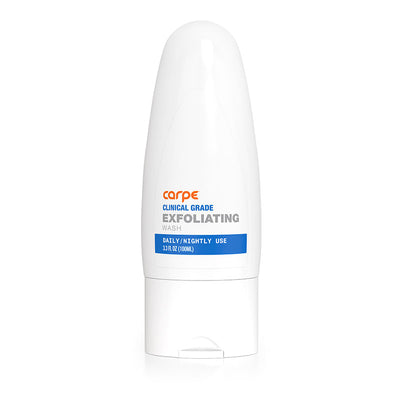Are you struggling with sweaty hands? You are not alone! Approximately 3% of the US population has a condition called hyperhidrosis that causes them to sweat excessively. Of the people who have hyperhidrosis, 90% experience hand, foot, or armpit involvement.[1] Here are some signs that your hand sweating may be excessive:
You sweat even when it isn’t hot
Your sweating interferes with your ability to do what you want
You feel self conscious about shaking hands because of your excessive sweat
You sweat so much that it causes you discomfort on a regular basis
If you can identify with the above statements, then you may be struggling with hyperhidrosis. Here are some of the causes of excessively sweaty hands and the things that you can do to help stop sweaty hands.[2]
How Hyperhidrosis Causes Sweaty Hands
The reason why humans sweat is to cool down the body and maintain a healthy internal body temperature (thermoregulation), but for people with hyperhidrosis, sweating occurs much more frequently than is necessary to keep the body cool.[1]
Hyperhidrosis causes sweat glands to be overactive which leads to excessive sweating, even in the absence of sweat triggers like heat. It doesn’t matter what the weather is like, people who have hyperhidrosis will experience excessive sweating even when there are no external reasons for it.[1]
The hands are one of the most common areas of the body affected by hyperhidrosis.[1] If you have hyperhidrosis, you may find that your hands are constantly sweaty and have no idea why. The skin on your hands may be white and peeling from the constant moisture.
Most people who struggle with sweaty hands have a form or hyperhidrosis called primary focal hyperhidrosis. Primary focal hyperhidrosis can also cause you to sweat excessively from your feet, armpits, face, or groin. Hyperhidrosis that affects the hands is known medically as palmar hyperhidrosis. Many times people with hyperhidrosis are affected on several parts of their body. Therefore, it is likely that you are dealing with excessive sweating on another part of your body in addition to your hands. If this is the case then don’t worry, there are several effective sweaty hand treatments you can use to help stop sweaty hands and improve your quality of life.[1]
Factors that Make Sweaty Hands Worse
If you are struggling with sweaty hands you’ll know just how debilitating and embarrassing this condition can be. There are several surprising factors that can cause palmar (hand) hyperhidrosis or worsen the condition.
Your Genes
Unfortunately, those constantly sweaty palms could be the result of some bad luck with your genes. One famous study carried out at the University of California in 2002 demonstrated that many debilitating cases of palmar hyperhidrosis are indeed the result of ‘faulty’ genes passed down from generation to generation. It is now thought that hyperhidrosis is hereditary, at least in part.[3]
This highlights the fact that your symptoms aren’t necessarily the result of stress or emotional issues, although hyperhidrosis and anxiety are often related. However, don’t think that healing is an impossibility - there are many treatments that can make a big difference.[1]
You’re Battling Stress
Most of us have experienced sweaty palms when something stressful happens, such as an examination, a marriage proposal or speaking in public.
This is because the stress has triggered our fight-or-flight response, releasing the stress hormones epinephrine and cortisol. These hormones help us cope with the stress, but also raise our body temperature.[4] Naturally, our bodies work to reduce this temperature in the way they know best - by activating your sweat glands. If you’re under chronic stress, your body is constantly on high alert and you are likely to continue to sweat around the clock and experience what is known as stress sweat.[5]
Social Phobia
It’s often hard to tell which came first - social anxiety or sweaty hands. However, there’s no doubt that the two feed a vicious cycle. Hyperhidrosis and anxiety often go hand in hand.
The scenario is a familiar one - you feel terribly ashamed about your sweaty hands and feel that other people will look at you in disgust and judge you negatively. So, when the bank manager goes in for the formal handshake, you feel yourself becoming insecure. Or when your gorgeous date reaches for your hand affectionately, that familiar dread rises up. Scenarios like these trigger your fight-or-flight response, your stress hormones kick in, and your palms get sweaty.[5] This will only reinforce your social phobia and make you more likely to avoid this kind of scenario in the future.
Low Blood Sugar
If you constantly crave sugary snacks and often skip meals you could be suffering from low blood sugar. This can also happen if you are suffering from diabetes.
Blood sugar issues could be worsening your palmar hyperhidrosis. Your body needs a constant supply of energy in order to work efficiently. However, when you eat these kinds of sugary foods or go for a long time without eating, your blood sugar levels can fluctuate wildly. In order to cope, it releases stress hormones like epinephrine which stimulate the release of sugar from your body stores. It also triggers symptoms of stress like sweaty palms and shaking.[6]
Too Much Alcohol
Many of us enjoy a glass or two of something alcoholic to help us wind down at the end of a long day. There’s nothing wrong with that!
Nonetheless, alcohol can be a big problem if you’re vulnerable to sweaty palms. Alcohol can cause excessive sweating, and it can worsen, or even trigger symptoms to begin. This is because alcohol causes your blood vessels to dilate which has a warming effect on your skin. This causes your parasympathetic nervous system to kick in, releasing plenty of sweat to help bring your body temperature back down.
These symptoms get worse the more alcohol you consume, and can hit chronic levels for those who become addicted.[7]
Spicy Foods and Coffee
While spicy foods and coffee are unlikely to cause severe sweaty palms, they can have an effect on the body’s ability to maintain its internal temperature. These substances can worsen sweating symptoms you might already be suffering, especially if you are sensitive to spice or caffeine. Caffeine can be a trigger for excessive sweating, so it is a good idea to use it in moderation.
Both spices and caffeine can activate neurotransmitters like acetylcholine, which cause your sweat glands to overreact and produce excessive amounts of sweat. They can also trigger the release of stress hormones which can further worsen the problem.[8]
Secondary Generalized Hyperhidrosis
Certain underlying diseases, conditions, or medications can cause a subtype of hyperhidrosis called secondary generalized hyperhidrosis. If you have one of these conditions it can increase your likelihood of experiencing sweaty hands, although sweating caused by secondary hyperhidrosis tends to affect the whole body rather than specific areas.[1]
Thyroid diseases are known to cause excessive sweating. Hyperthyroidism is an autoimmune disease which causes your immune system to attack your healthy cells, which then increases your body temperature.[9] This is similar to the way your body reacts when you are fighting off the flu. In an attempt to bring your temperature down, your parasympathetic nervous system will kick-in, releasing yet more sweat.
Hormonal fluctuations related to menopause can also cause excessive sweating. Hot flashes and night sweats are a well-known part of the menopause and can cause excessive sweating on the palms, hands, feet, and the rest of the body. This is due to fluctuating levels of the reproductive hormones estrogen and progesterone, which interfere with the body’s temperature regulation process. These hormones trigger those hot and sweaty moments. If you’re especially hormone-sensitive, this process can lead to severe symptoms that can last many years if not addressed.[10]
Sweaty palms are not your fault or a sign of weakness! There are many potential causes of sweaty hands, including lifestyle factors, genetic factors, and health conditions and none of them should be considered to be a personal failing.
What are Some Tips for Dealing with Sweaty Hands?
There are both medical and nonmedical approaches to dealing with sweaty hands and help stop sweaty hands embarrassment. Deciding which method works best for you is a personal choice that depends on your preferences and needs. Here are some options you may want to consider!
Practical Tips
There are a number of sweaty hand treatments you can pursue to reduce your sweating. Before we get to that, let’s look at some of the alternative methods you can use to manage hyperhidrosis of the hands:
-
Wearing gloves:While this clearly isn’t a permanent solution, it can be a temporary fix that will let you pursue some recreational activities with more confidence. Batting gloves can be worn during softball or baseball to let you get a better grip on your bat to help with your hitting. You won’t look out of place because many athletes wear these kinds of gloves. When kayaking, you can wear gloves to help you hold on better to the paddle. As an extra perk, the gloves will help you avoid any blisters you might get from longer paddling sessions. There are many instances where wearing the right clothes can help people who sweat excessively.
-
Finding your happy place:Finding ways to relax can alleviate some of the sweating. It isn’t a cure-all, but people with hyperhidrosis sweat more often than when they are anxious, so relaxing can help. Whether it’s meditation or yoga, using anxiety reduction methods can lessen excessive sweating and help you avoid some avoid and control anxiety.[5]
Medical Treatments for Sweaty Hands
If you’re looking for something to help you substantially reduce the sweat on your hands here are some medically proven treatments you may want to consider. You don’t have to simply put up with sweaty hands for the rest of your life – there are measures you can take to banish this problem, or at least significantly reduce your symptoms.
Antiperspirant
Surprisingly, antiperspirant is another type of sweaty hand treatment. Your armpits aren’t your only body parts that can benefit from wearing antiperspirant - you can use it on your hands to help stop sweaty hands as well. It is also important to understand what antiperspirant does and how it differs from deodorant. Antiperspirant actually blocks sweat glands so that sweat can't reach the surface of the skin. This is unlike deodorant which masks the smell of sweat and contains some antibacterial properties.[1]
The good thing about antiperspirant is that it is widely available and noninvasive. You can start off by trying over-the-counter antiperspirants, but you may end up needing a prescription antiperspirant. It can be confusing for people to figure out how to choose the right over-the-counter antiperspirant, but understanding the ingredients in antiperspirants can help. Before you upgrade to the next level of antiperspirant, you’ll want to make sure you’re applying the over-the-counter products correctly to give it the best chance of being successful. Here is how you should be applying it:
-
Put it on at night:This is a good strategy to follow because most people with primary focal hyperhidrosis find they don’t sweat while they’re sleeping. And to give antiperspirant time to set, it should be applied while hands are as dry as possible.
-
Wash your hands first:By washing and drying your hands right before applying your antiperspirant, you’ll be getting your hands dried off so the antiperspirant will adhere to your skin better.[9]
Some have had concerns that antiperspirant is not safe, but no studies have found that to be true. However, if you’ve tried antiperspirant for a while with limited or no success and you want to try another treatment, you’re in luck. There is more you can be doing. [11]
Iontophoresis Machine
Iontophoresis is a treatment for palmar and plantar hyperhidrosis that can be very effective. This low-intensity sweaty hands treatment sends low-voltage electrical currents into a pan of water in which your hands or feet are sitting.[1]
The electric current can reduce how active your sweat glands are. However, it won’t work right away. You might have to do as many as 10 sessions before you notice a real improvement. After that, you can reduce the frequency of the treatments and just set up a maintenance schedule.[1]
This procedure can be performed in a doctor’s office or at home after your doctor writes you a prescription for the equipment. Iontophoresis really does work, and if you’re struggling and unable to get results, there are ways to make iontophoresis more effective.[1]
Although it may take a few sessions to see results, iontophoresis does work. Some studies have shown it helps stop sweaty hands and feet by as much as 81 percent. Although it doesn’t offer total sweat control, that 81 percent can be a life-changing amount for someone suffering from hyperhidrosis. [1]
Botox Injections
Botox treatment for palmar and plantar hyperhidrosis can be extremely helpful. The same compound that immobilizes people’s foreheads and is frequently used as a way to look younger can help with your sweaty hands as well. Botox injections can decrease the amount of sweat your palms produce for up to six months.[1]
The biggest drawback to this type of treatment is that it can be uncomfortable when receiving the botox injections.
Before consenting to botox injections you should find an experienced dermatologist. You should look for a doctor who is experienced in treating hyperhidrosis. To find a suitable professional, you might want to use the Physician Finder function on the International Hyperhidrosis Society’s website. [12]
Endoscopic Thoracic Sympathectomy Surgery
Many people have success in managing their sweaty hands by using a combination of sweaty hand treatment options. For some, however, these treatments are not enough. In that case, surgical treatment for primary focal hyperhidrosis may be necessary. This type of surgery is called endoscopic thoracic sympathectomy.[1]
This surgery should only be performed as a last resort though because it does carry side effects, like compensatory sweating, that may be worse than dealing with sweaty hands. [1]
Keep A Positive Outlook
Although having sweaty hands isn’t easy, there are many things you can do to improve your symptoms and help stop sweaty hands. There are better treatments on the horizon as future treatments and research for hyperhidrosis are being developed. One day in the near future, you may not even give your hands a second thought as you move through your day-to-day life. Until then, do what you can to limit the impact hyperhidrosis has on your life and do your best not to let your sweat get you down.
Sources
- Pariser, D. M. (2014). Hyperhidrosis (4th ed., Vol. 32). Amsterdam: Elsevier Pub. Co., 2014. Retrieved from https://www.elsevier.com/books/hyperhidrosis-an-issue-of-dermatologic-clinics/pariser/978-0-323-32607-0
- “Hyperhidrosis and Sweating: When Should You See a Doctor?” WebMD, www.webmd.com/skin-problems-and-treatments/hyperhidrosis-sweating-when-should-you-see-doctor#1.
- University Of California - Los Angeles. (2002, March 6). UCLA Study Finds Evidence That "Sweaty Palms" Syndrome Is Genetic And Underreported. ScienceDaily. Retrieved May 5, 2020 from www.sciencedaily.com/releases/2002/03/020301071230.htm
- The Effects of Stress on Your Body. (n.d.). Retrieved from https://www.healthline.com/health/stress/effects-on-body#1
- Stress Sweat Is Real, Here’s How to Manage It. (n.d.). Retrieved from https://www.healthline.com/health/stress-sweat
- How does diabetes cause abnormal sweating? (n.d.). Retrieved from https://www.medicalnewstoday.com/articles/317366
- Are night sweats a sign of alcohol withdrawal? (n.d.). Retrieved from https://www.medicalnewstoday.com/articles/324104
- What Makes You Sweat. (n.d.). Retrieved from https://www.webmd.com/skin-problems-and-treatments/ss/slideshow-sweat-causes
- Hyperthyroidism. (n.d.). Retrieved from https://www.healthline.com/health/hyperthyroidism
- Suszynski, M. (n.d.). Menopause and Sweating. Retrieved from https://www.webmd.com/menopause/features/menopause-sweating-11#1
- Nordqvist, C. (2017, December 21). Hyperhidrosis: Symptoms, causes, diagnosis, and treatment. Retrieved May 14, 2018, from https://www.medicalnewstoday.com/articles/182130.php
- Kamudoni, P., Mueller, B., Halford, J., Schouveller, A., Stacey, B., & Salek, M. (2017, June 8). The impact of hyperhidrosis on patients' daily life and quality of life: A qualitative investigation. Retrieved May 21, 2018, from https://hqlo.biomedcentral.com/articles/10.1186/s12955-017-0693-x






16790753702383.jpg?v=1679075372)

16790746985853.jpg?v=1679074700)


16790757289763.jpg?v=1679075731)










